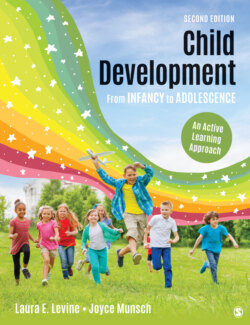Читать книгу Child Development From Infancy to Adolescence - Laura E. Levine - Страница 183
На сайте Литреса книга снята с продажи.
Chromosome Disorders
ОглавлениеGenetic disorders can also occur at the level of the chromosome. Chromosome disorders occur when one of the 23 pairs of chromosomes contains a number of chromosomes other than two. For example, Figure 3.5 shows the chromosomal configuration of an individual with Down syndrome. In the 21st position, there are three chromosomes rather than two. In another condition, Turner syndrome, there is only a single chromosome in the 23rd position in a female. Any deviation from the 46 chromosomes that are normally contained in 23 pairs will result in a chromosome disorder. Because a single chromosome contains a large number of genes, any deviation—whether an addition or a loss—results in a number of characteristics being affected.
Chromosome disorders: Disorders that result when too many or too few chromosomes are formed or when there is a change in the structure of the chromosome caused by breakage.
Figure 3.5 Chromosomes for Down syndrome.
Source: Biophoto Associates/Photo Researchers, Inc.
The second way a chromosome disorder occurs is when there is a change in the structure of the chromosome caused by breakage (NHGRI, 2016b). When sections of chromosomes break apart, they may not come back together in their original form. Some sections may be backward or may even link to a different chromosome. Both these types of abnormality may occur by chance, but the second type also can be passed along to a child by a parent who has such a damaged chromosome. Table 3.1 describes a number of conditions caused by chromosome abnormalities.
Table 3.1
Source: NHGRI (2013b, 2013c, 2016d, 2017).
As with all disorders, there is a range of effects resulting from chromosome disorders. For instance, children with Down syndrome have intellectual impairment, but some are profoundly impaired while others are better able to lead productive lives. It is impossible to tell at birth what level a child will reach. Therefore, it is important that these infants and their parents receive early intervention to help them achieve as much as they can.
Down syndrome. This boy has facial features that are typically associated with Down syndrome, including small upturned eyes, small ears, and a flat facial profile.
JSCook via Getty Images
